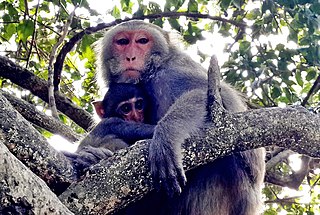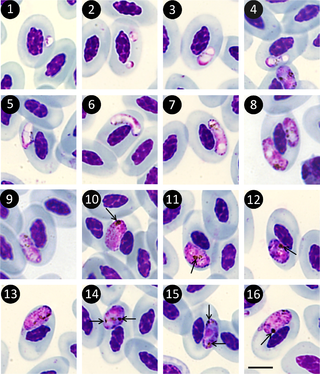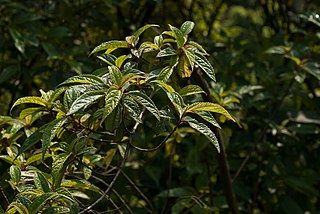
The macaques constitute a genus (Macaca) of gregarious Old World monkeys of the subfamily Cercopithecinae. The 23 species of macaques inhabit ranges throughout Asia, North Africa, and Europe. Macaques are principally frugivorous, although their diet also includes seeds, leaves, flowers, and tree bark. Some species such as the long-tailed macaque will supplement their diets with small amounts of meat from shellfish, insects, and small mammals. On average, a southern pig-tailed macaque in Malaysia eats about 70 large rats each year. All macaque social groups are arranged around dominant matriarchs.

The Formosan clouded leopard is a clouded leopard population that was endemic to Taiwan. Camera trapping studies carried out in several protected areas in Taiwan between 1997 and 2012 did not record any clouded leopard. The population is listed as extinct on the IUCN Red List.

The Formosan rock macaque, also known as the Formosan rock monkey or Taiwanese macaque, is a macaque endemic to the island of Taiwan, which has also been introduced to Japan. Besides humans, Formosan rock macaques are the only native primates living in Taiwan. The species was first described by Robert Swinhoe in 1862.

The Haemosporida are an order of intraerythrocytic parasitic alveolates.
Hepatocystis is a genus of parasites transmitted by midges of the genus Culicoides. Hosts include Old World primates, bats, hippopotamus and squirrels. This genus is not found in the New World. The genus was erected by Levaditi and Schoen, 1932, as Hepatocystes.
Hepatocystis bainae is a species of parasitic alveolates belonging to the phylum Apicomplexa
Hepatocystis carpenteri is a species of parasitic protozoa. They are transmitted by flies of the genus Culicoides and infect mammals.
Hepatocystis brosseti is a species of parasitic protozoa that infect mammals. They are transmitted by flies of the genus Culicoides
Hepatocystis hipposideri is a species of parasitic protozoa. They are transmitted by flies of the genus Culicoides and infect mammals.
Hepatocystis muuli is a species of parasitic protozoa. They are transmitted by flies of the genus Culicoides and infect mammals.
Hepatocystis epomophori is a species of parasitic protozoa. They are transmitted by flies of the genus Culicoides and infect mammals.
Plasmodium coatneyi is a parasitic species that is an agent of malaria in nonhuman primates. P. coatneyi occurs in Southeast Asia. The natural host of this species is the rhesus macaque and crab-eating macaque, but there has been no evidence that zoonosis of P. coatneyi can occur through its vector, the female Anopheles mosquito.

Plasmodium cynomolgi is an apicomplexan parasite that infects mosquitoes and Asian Old World monkeys. In recent years, a number of natural infections of humans have also been documented. This species has been used as a model for human Plasmodium vivax because Plasmodium cynomolgi shares the same life cycle and some important biological features with P. vivax.
Prunus phaeosticta, the dark-spotted cherry, is a species of Prunus native to China, including Taiwan, and southeast Asia, including far eastern India, Bangladesh, Burma, Thailand, Laos and Vietnam. It goes by a number of different names in Chinese, including 黑星櫻, black star cherry, 墨點櫻桃 and 墨点樱桃, ink point cherry, and 腺葉桂櫻, gland leaf cherry. It gets its specific epithet and its common names from the small dark spots (glands) on the undersides of its leaves. Formosan rock macaques eat the fruit.

Oreocnide pedunculata, the purple woodnettle or longpedicel woodnettle, is a species of flowering plant in the family Urticaceae, native to south-central and southern Japan, the Ryukyu Islands, and Taiwan. A shrub or small tree 2 to 5 m tall, it is found growing in valleys and forest edges at elevations from 100 to 1,200 m. Its leaves are an important food item for Formosan rock macaques and Japanese macaques.





